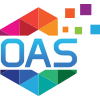Rasperry Pi Installation
Prerequisites
Before installing Open Automation Software (OAS) on a Raspberry Pi for industrial automation, you need to have a general knowledge of Linux server setup.
Whether you’re deploying in a factory, facility, or out at the edge, you should feel comfortable handling the following tasks:
- Managing user accounts
- Managing files and user permissions
- Transferring files between machines
- Networking configuration
- Configuring services (daemons in systemd)
Raspberry Pi Installation Video
Important
While OAS provides support for our platform installation and any related issues, support does not include managing Linux server configuration and administrative tasks.
For detailed Linux installation, see How to Install OAS in Linux
OAS Platform Support on Raspberry Pi 4 (minimum)
The Open Automation Software platform brings advanced industrial IoT (IIoT) capabilities to compact edge devices like the Raspberry Pi 4. When paired with a supported Linux server distribution, the Raspberry Pi becomes a flexible, cost-effective option for industrial automation.
An industrial Raspberry Pi can be used for everything from remote monitoring to real-time data collection in IoT environments. It’s a great fit for edge computing applications that need to integrate smoothly with existing control systems. OAS provides a reliable, full-featured platform to support these use cases and more.
Supported Protocols and Interfaces
OAS makes Raspberry Pi industrial automation possible by supporting a wide range of communication protocols:
- Modbus TCP, Modbus RTU, and Modbus ASCII for Master and Slave
- Allen Bradley ControlLogix, CompactLogix, GuardLogix, Micro800, MicroLogix, SLC 500, and PLC-5
- Siemens S7-200, S7-300, S7-400, S7-1200, and S7-1500
- OPC UA Server and Client
- MTConnect
- MQTT Broker and Client
- Azure IoT Data Hub
- AWS IoT Gateway
- Raspberry GPIO Pins
Warning
Classic OPC DA is not included for Linux deployments, but it can be networked from a Windows system running OAS.
Core Features on Raspberry Pi
All OAS platform features are supported for Raspberry Pi 4, making it easy to build a full edge-to-cloud IIoT with Raspberry Pi:
- Data logging and alarm logging to MSSQL Server and SQL Azure, Oracle, mySQL, MongoDB, MariaDB, PostgreSQL, Cassandra, SQLite, InfluxDB, and CSV files
- Realtime and historical trending
- Realtime and historical alarming
- Alarm notification
- Live visualization for web user interfaces
- Live visualization for remote .NET applications
- Full programmatic support of configuration, live, and historical data via REST API and .NET interface
Warning
Automated reports are not supported on Linux systems, but can be triggered over a network connection for execution from a Windows system.
Warning
While running OAS on a RaspberryPi 4+ is fully supported, the default Raspbian OS is not. Please choose one of the supported Linux distributions HERE, making sure to install a server variant as opposed to a desktop variant. Extensive testing with Ubuntu Server has proven to be the most reliable and simplest to configure.
